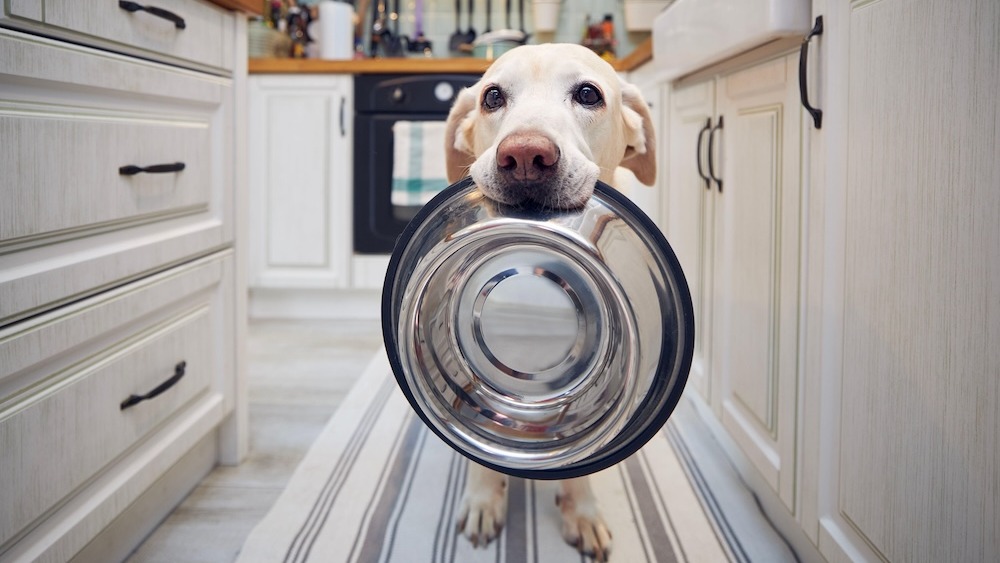Dog obesity is an increasingly common issue in the United States, affecting millions of pets each year. Obesity in dogs is not only a cosmetic issue; it is a serious health concern that can lead to joint pain, heart disease, diabetes, and even a shorter lifespan. As a pet owner, understanding the causes and consequences of obesity, as well as the best ways to manage it, can help your dog live a longer, healthier life. This article will focus on the role of a balanced diet in controlling dog obesity, providing veterinarian-recommended tips and dietary guidelines.
What is Dog Obesity?
Obesity in dogs is defined as an excess accumulation of body fat that exceeds the dog’s ideal weight by 20% or more. This condition is caused by an imbalance between calorie intake and energy expenditure, leading to weight gain over time. Although all dogs can become obese, certain breeds, such as Labradors, Beagles, and Bulldogs, are genetically predisposed to gaining weight.
Why is Obesity a Serious Health Issue in Dogs?
Obesity poses significant risks to your dog’s health and overall well-being. The extra weight puts stress on your dog’s bones and joints, leading to arthritis and joint pain. Additionally, it increases the likelihood of developing other health conditions such as:
- Diabetes: Overweight dogs are at a higher risk of developing diabetes mellitus, which requires lifelong management through insulin injections and dietary changes.
- Heart Disease: The added strain on the heart can lead to cardiovascular issues.
- Joint Problems: Obesity exacerbates conditions like hip dysplasia and osteoarthritis.
- Reduced Lifespan: Obese dogs tend to have shorter lifespans due to their increased vulnerability to these health conditions.
Recognizing and addressing dog obesity early can prevent long-term health complications. The cornerstone of managing obesity is a balanced diet designed to meet your dog’s nutritional needs without adding excess calories.
The Importance of a Balanced Diet
A balanced diet plays a critical role in managing dog obesity. Unlike crash diets, which can be harmful, a properly balanced diet provides the necessary nutrients while helping dogs maintain or achieve a healthy weight. Here’s how you can ensure your dog is eating a balanced diet:
1. Choose High-Quality Dog Food
One of the most important steps in managing dog obesity is choosing the right dog food. High-quality dog food should provide a balanced mix of proteins, fats, carbohydrates, vitamins, and minerals. Low-quality foods that contain fillers, artificial additives, or excessive fat can contribute to weight gain.
- What to Look For: Look for dog food that lists a quality protein source (like chicken, turkey, or fish) as the first ingredient. Avoid dog foods that are high in by-products, corn, or soy, as these can be harder for your dog to digest and may contribute to weight gain.
- Vet-Recommended Diets: Your veterinarian may recommend a weight management formula, which is specially designed to help overweight dogs lose weight without sacrificing essential nutrients.
2. Avoid Excess Calories
One of the primary causes of obesity is excessive calorie intake. Overfeeding, even if the food is high quality, can lead to weight gain if the dog’s activity level does not match the number of calories consumed. Pay close attention to portion sizes and avoid feeding table scraps or too many treats.
- Portion Control: Stick to the portion sizes recommended on your dog food label, but always consult with your veterinarian to determine the ideal calorie intake for your dog’s size, breed, and activity level.
- Limit Treats: Treats should be used sparingly, as they are often high in calories. If you do offer treats, choose low-calorie options and ensure they don’t exceed 10% of your dog’s daily calorie intake.
3. Select Low-Fat, High-Fiber Options
Many veterinarians recommend low-fat, high-fiber diets for dogs struggling with obesity. Low-fat dog foods help reduce the number of calories your dog consumes, while high-fiber options help them feel fuller for longer, reducing the likelihood of overeating.
- Benefits of High-Fiber Foods: Fiber helps with digestion and can prevent overeating by promoting a feeling of fullness. Look for dog food that includes natural fiber sources like pumpkin, sweet potatoes, or green beans.
- Low-Fat Proteins: Foods rich in lean proteins, such as chicken or fish, are lower in fat than options like beef or lamb. This helps reduce calorie intake without sacrificing essential nutrients that support muscle mass.
4. Monitor Your Dog’s Weight Regularly
Monitoring your dog’s weight is essential in preventing obesity. Regular weigh-ins at the vet or using a pet scale at home will help track your dog’s progress. By keeping a close eye on your dog’s weight, you can make necessary adjustments to their diet before obesity becomes a problem.
- Consult Your Vet: If you notice a sudden increase in your dog’s weight, or if they are not losing weight despite dietary changes, it’s important to consult with your veterinarian. Some underlying health conditions, such as thyroid disorders, may require treatment to support weight loss.
5. Exercise and Physical Activity
While a balanced diet is essential for weight management, exercise is just as important. Dogs need regular physical activity to burn calories and maintain muscle mass. Lack of exercise is one of the leading causes of obesity in dogs, especially in indoor pets with limited access to outdoor play.
- Daily Walks: Ensure your dog gets at least 30 minutes to an hour of exercise each day, depending on their breed and health condition. For overweight dogs, shorter but more frequent walks may be more appropriate to avoid overexertion.
- Interactive Play: Incorporate games like fetch or tug-of-war to keep your dog active. Puzzle toys that require your dog to work for their food are also great for stimulating their mind and encouraging movement.
The Role of Your Veterinarian in Managing Obesity
Managing your dog’s weight should be done in partnership with your veterinarian. A veterinarian can assess your dog’s body condition and recommend an appropriate weight loss plan. This may include a prescription diet, supplements, or adjustments to portion sizes. Regular veterinary visits allow for monitoring progress and making necessary changes to ensure your dog stays on track.
Conclusion
Dog obesity is a serious condition that requires a proactive approach to prevent long-term health consequences. By feeding your dog a balanced diet that meets their nutritional needs without excess calories, you can help them maintain a healthy weight and live a longer, healthier life. Always consult with your veterinarian to ensure that your dog’s diet and exercise routine are appropriate for their breed, age, and overall health. Through portion control, low-fat and high-fiber foods, and regular physical activity, you can significantly reduce the risk of obesity and improve your dog’s quality of life.



